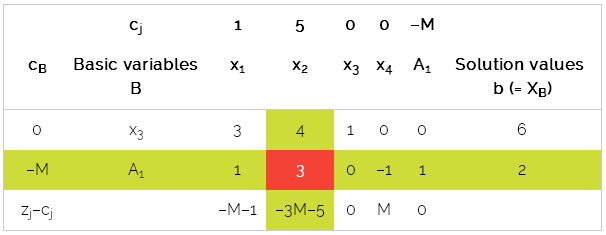Big M Method : Linear Programming
The big m method is a modified version of the simplex method in linear programming (LP) in which we assign a very large value (M) to each of the artificial variables.
We will illustrate this method with the help of following examples.
 Big M Method Example: LPP
Big M Method Example: LPP
Maximize z = x1 + 5x2
subject to
3x1 + 4x2 ≤ 6
x1 + 3x2 ≥ 2
x1, x2 ≥ 0
Solution.
Converting inequalities to equalities
By introducing surplus variables, slack variables and artificial variables, the standard form of LPP becomes
Maximize x1 + 5x2 + 0x3 + 0x4 – MA1
subject to
3x1 + 4x2 + x3 = 6
x1 + 3x2 – x4 + A1 = 2
x1 ≥ 0, x2 ≥ 0, x3 ≥ 0, x4 ≥ 0, A1 ≥ 0
Where:
x3 is a slack variable
x4 is a surplus variable.
A1 is an artificial variable.
Initial basic feasible solution
x1 = x2 = x4 = 0
A1 = 2, x3 = 6
The Big M Method: Table 1

Calculating values for index row (zj – cj)
z1 – c1 = 0 X 3 + (–M) X 1 – 1
= –M – 1
z2 – c2 = 0 X 4 + (–M) X 3 – 5
= –3M – 5
z3 – c3 = 0 X 1 + (–M) X 0 –
0 = 0
z4 – c4 = 0 X 0 + (–M) X (–1) –
0 = M
z5 – c5 = 0 X 0 + (–M) X 1 – (–M)
= 0
As M is a large positive number, the coefficient of M in the zj–cj row would decide the incoming basic variable.
As -3M < -M, x2 becomes a basic variable in the next
iteration.
Key column = x2 column.
Minimum (6/4, 2/3) = 2/3
Key row = A1 row
Pivot element = 3.
A1 departs and x2 enters.
Note that in the iteration just completed, artificial variable A1 was eliminated from the basis. The new solution is shown in the following table.
Table 2
| cj | 1 | 5 | 0 | 0 | ||
|---|---|---|---|---|---|---|
| cB | Basic variables B |
x1 | x2 | x3 | x4 | Solution values b (= XB) |
| 0 | x3 | 5/3 | 0 | 1 | 4/3 | 10/3 |
| 5 | x2 | 1/3 | 1 | 0 | –1/3 | 2/3 |
| zj–cj | 2/3 | 0 | 0 | –5/3 |
Final Optimal Table: The Big M Method
| cj | 1 | 5 | 0 | 0 | ||
|---|---|---|---|---|---|---|
| cB | Basic variables B |
x1 | x2 | x3 | x4 | Solution values b (= XB) |
| 0 | x4 | 5/4 | 0 | 3/4 | 1 | 5/2 |
| 5 | x2 | 3/4 | 1 | 1/4 | 0 | 3/2 |
| zj–cj | 11/4 | 0 | 5/4 | 0 |
The optimal solution is:
x1 = 0, x2 = 3/2
z = 0 + 5 X 3/2 =15/2



